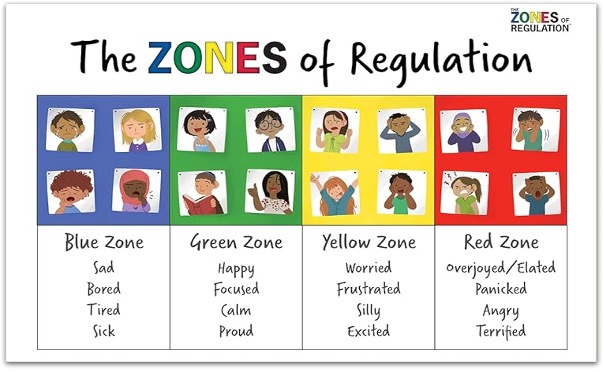Zones of Regulation
The Zones of Regulation is an internationally renowned intervention which helps children to manage difficult emotions, known as ‘self-regulation’.
Self-regulation can go by many names, such as ‘self-control’, ‘impulse management’ and ‘self-management’. Self-regulation is best described as the best state of alertness for a situation. For example, when your child takes part in a sports game, they would need to have a higher state of alertness than when, for example, they were working in a library.
From time to time, all of us (including adults) find it hard to manage strong feelings such as worry, anger, restlessness, fear or tiredness, and this stops us from getting on with our day effectively. Children who feel these emotions often find it hard to learn and concentrate in school. The Zones of Regulation aim to teach children strategies to help them cope with these feelings, so they can get back to feeling calm and ready to learn. These coping strategies are called ‘self-regulation’.
At Leafield C.E. Primary School, we recognise the importance of promoting positive mental health and emotional wellbeing for our students and their families. We aim to create an open culture around the discussion of mental health and wellbeing and to empower our children to be able to regulate their emotions. By implementing the Zones of Regulation curriculum, we aim to teach our pupils to identify emotions in themselves and others and provide them with a bank of strategies to help regulate their emotions and improve their wellbeing.
The Zones of Regulation is a curriculum based around the use of four colours to help children self-identify how they’re feeling and categorise it based on colour. The curriculum also helps children better understand their emotions, sensory needs and thinking patterns. Children learn different strategies to cope and manage their emotions based on which colour zone they’re in. Additionally, the Zones of Regulation help children to recognise their own triggers, learn to read facial expressions, develop problem-solving skills, and become more attuned to how their actions affect other people.
There is progression across the curriculum with children in Early Years learning to identify different emotions to children in Upper Key Stage 2 discussing how our behaviour can impact upon the feelings of those around us.

What is the Blue Zone?
The blue zone is used when a person is feeling low state of alertness. Our brain and body are moving slowly and sluggishly.
When we’re in the blue zone we may be feeling down – sad, sick, tired, or bored. We’re still in control, as we are in the yellow zone, but with low energy emotions.
What is the Green Zone?
The green zone is used to describe when we’re in a calm state of alertness and in control of our emotions.
Being in the green zone means we are calm, focused, happy, or ready to learn. This is predominantly the state you want your child to be in. It’s also the state most needed in the classroom in order to learn.
What is the Yellow Zone?
This is the zone where we experience more intense emotions, but we are still able to maintain a level of control. We are in a heightened sense of alertness, but we do still have some control.
Being in the yellow means we may be feeling worried, frustrated, anxious, excited, scared, overwhelmed or nervous.
What is the Red Zone?
The red zone describes an extremely heightened state of intense emotions. This is when we are struggling to control our emotions or reactions.
We may be feeling anger, rage, out of control or terrified. We may be hitting out or becoming physical with others.
